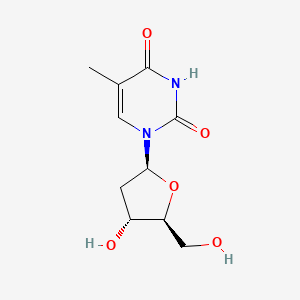D0117 | Telbivudine
J
J05AF11 Telbivudine
[J05AF] Nucleoside and nucleotide reverse transcriptase inhibitors
[J05A] DIRECT ACTING ANTIVIRALS
[J05] ANTIVIRALS FOR SYSTEMIC USE
[J] Antiinfectives for systemic use
| Pictogram | Signal | Statements | Precautionary Statement Codes |
|---|---|---|---|
 |
Warning |
Aggregated GHS information provided by 39 companies from 2 notifications to the ECHA C&L Inventory. Reported as not meeting GHS hazard criteria by 1 of 39 companies. For more detailed information, please visit ECHA C&L website Of the 1 notification(s) provided by 38 of 39 companies with hazard statement code(s): H302 (100%): Harmful if swallowed [Warning Acute toxicity, oral] Information may vary between notifications depending on impurities, additives, and other factors. The percentage value in parenthesis indicates the notified classification ratio from companies that provide hazard codes. Only hazard codes with percentage values above 10% are shown. |
P264, P270, P301+P312, P330, and P501; (The corresponding statement to each P-code can be found at the GHS Classification page.) |
| 1-((2S,4R,5S)-4-hydroxy-5-(hydroxymethyl)tetrahydrofuran-2-yl)-5-methylpyrimidine-2,4(1H,3H)-dione | 1-((2S,4S,5S)-4-hydroxy-5-(hydroxymethyl)-tetrahydrofuran-2-yl)-5-methylpyrimidine-2,4(1H,3H)-dione | 1-(2-Deoxy-beta-L-erythro-pentofuranosyl)-5-methyl-2,4(1H,3H)-Pyrimidinedione |
| 1-(2-Deoxy-beta-L-erythro-pentofuranosyl)-5-methylpyrimidine-2,4(1H,3H)-dione | 1-(2-Deoxy-beta-L-erythropentafuranosyl)-5-methyl-2,4(1H,3H)-pyrimidinedione | 1-(2-deoxy-beta-L-ribofuranosyl)-5-methyluracil |
| 1-[(2S,4R,5S)-4-hydroxy-5-(hydroxymethyl)oxolan-2-yl]-5-methyl-1,2,3,4-tetrahydropyrimidine-2,4-dione | 1-[(2S,4R,5S)-4-hydroxy-5-(hydroxymethyl)tetrahydrofuran-2-yl]-5-methyl-pyrimidine-2,4-dione | 1-[(2s,4r,5s)-4-hydroxy-5-(hydroxymethyl)oxolan-2-yl]-5-methyl-pyrimidine-2,4-dione |
| 2'-Deoxy-L-thymidine | 2,4(1H,3H)-Pyrimidinedione, 1-(2-deoxy-b-L-erythro-pentofuranosyl)-5-methyl- | 2-Deoxy-L-thymidine |
| 26879-47-0 | 2OC4HKD3SF | 3424-98-4 |
| 5-methyl-l-uridine | AB01274717-01 | AB01274717_02 |
| AB2000195 | AC-5632 | AKOS025117349 |
| API0025947 | AS-35209 | BDBM50088372 |
| BRD-K15976406-001-01-7 | CHEBI:63624 | CHEMBL374731 |
| CS-1934 | CT-990 | D06675 |
| DB01265 | DTXSID30187813 | Epavudine |
| Epavudine;L-Thymidine;NV 02B | GC4386 | HY-B0017 |
| IQFYYKKMVGJFEH-CSMHCCOUSA-N | L-Deoxythymidine | L-Thymidine |
| L-dT | LDT-600 | LDT600 |
| LLT | LS-186402 | LS-187347 |
| LdT | MFCD02683612 | NB 02B |
| NCGC00346560-01 | NV 02B | NV-02B |
| Q413621 | SB20806 | SCHEMBL124279 |
| SW220236-1 | Sebivo | Sebivo;Tyzeka |
| Telbivudin | Telbivudine | Telbivudine (Sebivo, Tyzeka) |
| Telbivudine (USAN/INN) | Telbivudine [USAN:INN:BAN] | Telbivudine [USAN] |
| Telbivudine(Tyzeka, Sebivo) | Telbivudine, >=98% (HPLC) | Thymine, 1-(2-deoxy-.beta.-L-erythro-pentofuranosyl)- |
| Thymine, 1-(2-deoxy-beta-L-erythro-pentofuranosyl)- | Tyzeka | Tyzeka (TN) |
| UNII-2OC4HKD3SF | Z2574360267 | ZINC2159 |
| b-L-2'-deoxy-thymidine | beta-L-2'-Deoxythymidine | beta-L-Thymidine |
| s1651 |
| DrugBank Name | Telbivudine |
| DrugBank | DB01265 |
| CAS Number | 26879-47-0, 3424-98-4, 50-89-5 |
| PubChem Compound | 159269 |
| KEGG Drug | D06675 |
| PubChem.Substance | 46508706 |
| ChEBI | 63624 |
| PharmGKB | PA164760861 |
| ChemSpider | 140081 |
| BindingDB | 50088372.0 |
| TTD | DAP000698 |
| Wikipedia | Telbivudine |
| HET | LLT |
| DPD | 20037 |

